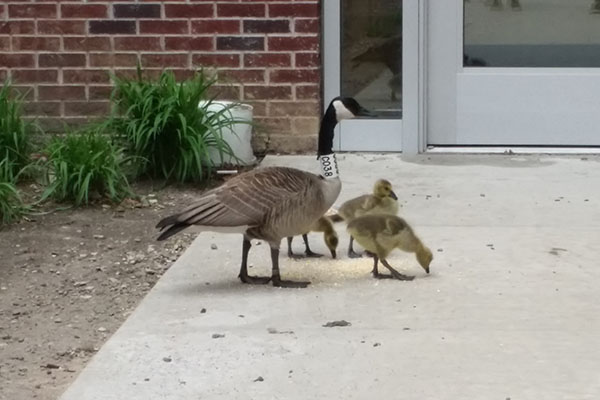Duck, duck … geese?
May 18, 2016
An RB anomaly for the past 15 years is the nesting courtyard geese. These geese have been a very popular sight from the windows of the hallways. While the geese might be a calming sight during the stressful end of the year, things haven’t always been this way for the geese.
In the early days of the courtyard geese, things were very stressful for both staff and students. While the courtyard is protected from ground predators, RB used to see many large crows in the area.
While male geese usually stay with their mate during the incubation period, that hasn’t always been the case with the courtyard geese.
“This year the male is here, we’ve never had the male stay,” said Mari Mortensen, an RB social worker.
As the baby geese are very small, the large crows could very easily fly down into the courtyard and carry away the defenseless babies. In past years this has happened when the female was away and there was no male to guard them.
This created a very stressful situation for staff because students who witnessed the baby geese being taken were often traumatized. In an attempt to stop the geese from nesting in the courtyard, staff tried placing netting over the top of the courtyard and buying powdered coyote pee to repel them. All attempts were unsuccessful.
As a last resort, one year Mortensen placed the entire nest in a cardboard box and drove it to a nearby wildlife sanctuary. The sanctuary staff were very upset with Mortensen for disturbing a wild nest, but she insisted it was necessary for the protection of the babies and the students.
In a drastic turn of events, the bird flu swept through the crow population about eight years ago and severely reduced the number of large crows in the area. The reduction in crow populations meant good things for the geese and staff. The babies were no longer preyed upon by the large birds and staff no longer had to struggle to protect the students from seeing the scene.
“They need a good running start to fly, babies have a lot of difficulty flying out,” said Dave Monti, an RB science teacher and Eco Club sponsor.
While the babies were safe from the crows, they were still trapped in the courtyard. Geese will stay with their parents as long as the whole first year of their life, but in order to do that the babies need to be able to follow their parents.
“It is very safe in there, but the babies can’t fly out, they’re stuck,” said Mortensen.
The courtyard is small, and the walls are very tall and steep. Having little to no experience flying, the babies are often unable to leave the courtyard when their parents do, which means they are limited to living off of what is available in the courtyard.
Mortensen has been providing a poultry mix recommended by a local feed store for the babies and dried corn for the mother. She has also provided a water trough for the babies to drink. While it may seem like the right choice to feed the baby geese stuck in the courtyard, there are some downsides to providing food.
“If you’re going to feed and water them, you need to do that until they are adults and can fly out,” said Monti.
While the baby geese have done nothing wrong, there species is still considered by many to be a pest bird. In 1962, the Giant Canada Goose was thought to be extinct. Although in the past they were endangered, the goose populations in suburban Chicago have gotten out of hand.
“Let nature take it’s course, they are not an endangered species,” said Monti.
Part of the problem with the geese is that residents are feeding them, convincing the geese that food is available year round. This means they are able to stay and winter over in the area with an ample supply of handouts.



